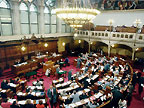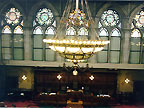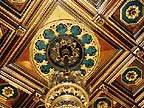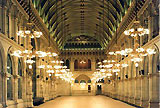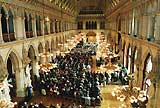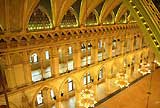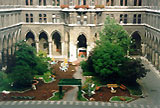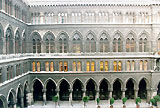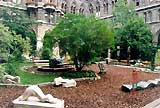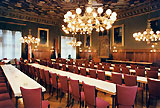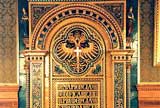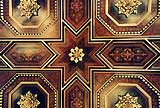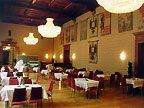Friday, February 2, 2007
And the Internship Goes To...
In other internship-related news, I recieved an offer from Merrill Lynch for a second round interview. Don't ask me how that happened, I could have sworn that I royally messed up the first one I had with them. Apparently, they thought differently. When it rains, it pours I guess. I won't have that interview until the end of February, and then there's the one with Boeing in the middle of February. Hopefully, one of them will yield an interesting (and well-paying) internship over the coming summer. With Merrill Lynch, I'd be in New York City and with Boeing I'd be in Seattle. Just keep your fingers crossed people!
The rest of tonight should be filled with packing and chilling out. Sarah and Alison and Travis already left for Rome, they were taking the overnight train like I will be for Easter break. If I have the inclination later on tonight, I'll add some details on each flatty to my blog, as per several requests. But for now, I think I'll make my lunch for tomorrow and see if there's anything else I can pack. I'm going to do it all in once backpack, which is very awesome, and that's with my laptop. It's probably going to be a bit heavy, but I'll still be able to blog and upload pictures.
Love you all!
Amanda
Interviews Round 2
Now I guess I should tell you about actually getting to the interview, because it was rather harrowing! On the map, it looked easy-peasy, but in real life it wasn't quite that way. Taking the subway wasn't a big deal, even though I still really don't like them. I think it has something to do with hearing about NYC's Molepeople. They just kind of creep me out. After the subway, I had to take the Straßenbahn about two stops and get off and walk a couple of blocks. There's two S-Bahn's that go in the direction I needed to, the 21 and the N. When I looked at the map, I thought I was looking at the 21 when I was actually looking at the N. The 21 turns before it gets to the stop I want. Since I was like, oh, they both go the same way, I'll just get on whichever comes first, I got on the 21. When I realized that it wasn't actually going to get to the stop I wanted, I figured I'd just stay on it til the end and it would have to loop back. Now I'm lucky that I planned on arriving early, or else I would have had an even bigger problem. Because apparently, trains in Europe don't have short runs like they do in State College. Because it was 12:05 and we had just reached the end of the line. Keep in mind that my appointment was at 12:00. The driver looked back at me in his little mirror like, "Why are you still here?" so I walked up and uttered the most important phrase an American needs in any German-speaking country..."Sprechen Sie Englisch bitte?" Fortunately for me, he said that he could, then showed me the map of where I needed to get off. After he took his break, he turned the S-Bahn back on and proceeded to drive about 6 miles per hour back to where I needed to be. Now, he was a very nice man, but I was late already and having a heart attack in his trolley. By the way, in all of this confusion, I found a tack shop in Vienna, which is cool in and of itself. I'm pretty sure I wouldn't have found it if I hadn't been "lost," but it's just nifty to know that they exist here too. :-) Once we were at the stop I needed, the driver made a point of looking back in his mirror and catching my eye to make sure I got off. On another side note, on the way back, we picked up a beggar. I don't know why, but besides being a totally new experience for me, I felt kind of weird. I mean, you see beggars on the streets, usually from eastern Europe or Turkey, but to be approached by one in the S-Bahn was somehow different. Harder to ignore I guess. Anyway, I got off where I was supposed to this time, and then had to ask directions from a girl at the cross-walk. She said she didn't know, but there was a map there, and she explained to me how to get where I wanted to go. Now I want you all to be very impressed, because all of this was in German, and I GOT IT!! Sehr toll. I finally managed to get to my interview around 12:25. Not a great way to start off, but he was nice about it, and I made sure to apologize in German.
Getting back to IES wasn't as bad. I had it figured out by then. I gave a group presentation in German class on "Der Standard," one of the papers in Austria. It's a pretty cool paper, kind of like the New York Times, and the presentation went well. We didn't even have the fire drill in the middle of ours like we thought we were going to.
I had some time to kill before our Berlin Tour meeting, so I got online and chatted with Matt and some people from home. But mostly Matt. :-) At the meeting, we were told that we were going to be visiting five cities instead of the original three. Starting Saturday morning, we'll be visiting Prague, Dresden, Weimar, Berlin, and Pottsdam. I'll be gone for ten days, but I'm hoping to bring my laptop with me so I can keep blogging. Also, I can't call anybody while I'm outside of Austria, but I think it's still either free or cheap for me to recieve calls. But I plan on taking a lot of pictures, and seeing so many things! It's going to be super wonderful, and towels are provided. You laugh at that, but at a lot of hostels here, they aren't and they take up a lot of room. I think I'm only bringing two backpacks, so it's going to be tight anyway. Adding in a towel or two would cause zipper-bursting!
We invited Laura for dinner last night because Alex, our pseudo-RA, made us Tirolean Knödeln. They're kind of like dumplings with pieces of meat and spices in them, and then in a chicken broth. They're amazing. I ate three and I was full. Each one is almost the size of my fist, and Alex made it all from scratch. We also sprung for a two-Euro bottle of wine, which is like wonderful. Usually we only go for one-Euro bottles, which can be hit or miss. But this one was a winner.
Now a very curious thing happened. I checked facebook because I swear I'm addicted, and lo-and-behold, some other chick posted on Matt's wall. I consider this somewhat of an affront, because I kind of claimed his wall as my turf and I tend to take it over. Then she said that she wanted him to teach her to dance and that they should be dance partners for life. Hmm. I was kind of bent out of shape about all of this, and wrote on there that there was talkage necessary. Facebook for Matt is really nifty because it goes to his phone, so I knew he'd get it.
Then I went and had a chat with Mom and Erika about this whole internship dealy, then my phone started to ring after I had hung up with them. Since nobody ever calls me (mostly because my phone is always off) this was one of those Major Life Events. It turned out that it was Hunny, and he thought he was in trouble. Of course he wasn't and went on to explain that the chick that wrote on his wall was married to his best friend. Oops. After that all was cleared up we had a very nice and very silly conversation. :-) He had to go teach snotty little kids (literally) how to swim, so it wasn't a super long conversation, but we got to talk later on AIM. The rest of the night was devoted to being unproductive and saying that I was going to study, but I never actually got motivated enough to do so.
This morning we had our German finals, which is very exciting, because we went through about 37.5 hours of German class in the last week. It's CRAZY I tell you. But now it's all over and I think I did a fairly decent job. So yeah. That's all for now, folks!
Hopefully, I'll have my computer with me, but if I don't, look for massively long blog postings in a week and a half.
Love always,
Amanda
Thursday, February 1, 2007
So About that Picture Thing...
community.webshots.com/user/von_Wein_mit_Liebe
That is all. Look for a new post either later tonight or tomorrow afternoon while I'm waiting for my laundry to dry.
Love,
Amanda
PS -- If you want to donate to the "Get Matt to Vienna Fund" please let me know. :-)
Wednesday, January 31, 2007
Interviews Round 1
www.community.webshots.com/users/von_Wien_mit_Liebe
And in other news, I had my first interview today for the business internship. Today was with the Bank of Austria and Dr. Oswald. I had to take the U-Bahn, and let me tell you, I was nervous. I don't know why, but subways kind of really freak me out. It turned out ok because I got off at the right stop and didn't get ticketed for not having a transportation pass. I might buy one tomorrow just for my peace of mind. I was dressed in business casual and I think I looked pretty good. My feet were hurting, so I know my shoes looked good. Dr. Oswald was in a three-piece suit. Today we spoke in English so I would understand what I would be doing for him if I took this internship. In my mind, I would be an executive assistant because I would be proofing his presentations (in German) and setting up PowerPoint presentations for him (also in German). I could work almost like a flex time schedule. He expects me to work a couple of evenings a week, maybe six hours in total at the Bank of Austria, and the rest I can do on my laptop at home. IES wants me to work ten hours a week, and if I can do some of that on my own time at home, it will be a lot more manageable with my expected class schedule. It was a really interesting interview, and I think I could learn a lot from Dr. Oswald. He's a very personable man, and he informed me that there is no dress code (yay!), which means that when Mom and Dad visit me in March or April, they can take my business clothes with them and I won't need to cart them around Europe at the end of the semester. Until then, I'll do my best to look nice.
I had planned on going to the Opera today, but yesterday I got a slip from the post office that said I had to pick up a package. I brought my passport with me to get it today and as it turns out, that one package was actually two! I got one from Mom and another from Matt. I carted them over to IES and had to have Gretl buzz me in because I couldn't hold the packages, punch in the code, and open the door all at the same time. She looked at me through the window inbetween the two doors and started laughing at me. I went in to thank her and Gretl asked if it was Christmas. In my mind, it was pretty much as good as Christmas, and I said so. Then I hauled them up four flights of stairs and opened the one from Matt because it was smaller. He sent me some Ramen, cookies, the cheese and peanut butter crackers, and a box of My Little Pony fruit snacks! There was also a letter in there, but I was really excited about the MLP fruit snacks! I shared with a couple of girls from my class and everybody that walked by was really impressed with how much my people love me.
The real trick of the day was bringing the boxes home. I had my backpack with my laptop, and then these two boxes as I was walking along the main drag in center city. Needless to say, the man at the Kebab near IES was looking at me as I carried them all home. I got a lot more looks on the S-Bahn and bus. But it was cool, because I had Christmas in January. It was kind of like being Orthodox, but even better. Getting into my building was a bit harder than imagined, but not like trying to get into IES. I didn't expect anybody to be home, so I was really surprised when I got upstairs and saw Alison and Jeremy. Jeremy asked if he could help, which was nice, but it would have been better about 45 minutes before. Then I got to unpack everything. It was amazing. I got somewhere around 28 packets of Ramen. :-) And two big tubs of extra crunchy Jif peanut butter. And lots of assorted snack food. Then Mom made my day and sent me a sweater I wanted but didn't ask for and my favorite teal purse. I was super excited. And now my whole shelf in the unit we store our dry goods in is full to the brim. It finally looks like I've moved in for a while. I like it a LOT!
And that pretty much sums up my day. Now all I have left to do is put up the Ball pictures and finish this blog and write a presentation for tomorrow's German class.
Love and kisses,
Amanda
Tuesday, January 30, 2007
Heuriger and the Rathaus
On Sunday, like I mentioned before, we were bums. Half of us didn't get dressed and only Jeremy ventured outside. But it was really nice. And the perfect chill-out day.
Yesterday, I skyped Matt and Erika after class, and my German class went to a Heuriger for dinner. It was pretty far outside the first district, and we were on the S-Bahn forever to get there. Coming back wasn't so bad because we got to take the U-Bahn.
Heuriger (pronunciation: English 'hɔɪ rɪ ɡə], German 'hɔy rɪ ɡɐ) is the name given to many Austrian wine-drinking locales where patrons can experience Gemütlichkeit. Originally only the most recent year's wine was served at such an establishment. Heurig meaning this year's (as an adjective) in Austrian German; thus, a Heuriger.
A Heuriger has legal limitations different from those of a tavern or restaurant. Only its own wine can be served, and it is limited to serving a limited selection of food from a buffet. Many places still provide a very nice selection of small cold dishes, for example Liptauer spread and even several different hot plates, for example Wiener Schnitzel. Additionally, a Heuriger can only be open a certain amount of time per year. In areas with many Heurigen, people generally know about the scheduled openings of other establishments, and it is usually guaranteed that there will be at least one or more Heurigen open. Open Heurigen indicate that guests are welcome with a couple of conifer or fur twigs, or Buschen, hung above the entrance door.
For financial reasons, many Heurigen are opening attached restaurants that sell other foods and also beer, for example. Purists would consider these Pseudo-Heurigen.
At the beginning of the 20th century, it was customary to bring one's own food, or other drinks, to a Heuriger. To make an establishment more profitable, in many places, the place would be leased to different winemakers or winzers. These establishments therefore have the name Winzerstube.
As a side note, all of the Heurigen have to be on the foothills outside the city. It's some kind of law.
I really enjoyed the Heuriger. We got a bread course with salad (which is very different than American salad) then there was the meat course, which was a plate full of meat. It was wonderful. Then there was another bread course, but it came with flavored spreads. This was also very, very good. And of course, we each got wine. I had red. I'm not a great fan of red wine because it'll make my teeth dark, but this was pretty good red wine. All of that was covered by IES, we only had to pay for dessert if we wanted it. What kind of person would I be if I passed up dessert? I had apple strudel with cream. It was really good. Everything was really good, and even better, I wasn't still hungry at the end. I think that's the problem with fending for yourself, you tend to fend on a low-level.
After Travis and I got back to the apartment, the flatties decided to go out to a bar for a bit. I wanted to stay in and work on my travel plans. Meghan and I solidified our plans for Rome, and I made the reservations. So it's for real now, I'm going to Galway for St. Patty's Day and Rome for Easter. It's really cool. And we got tickets for all of the Holy Week events. So I'm going to see the Pope. Since I'm not a Catholic, I'm not spasming over this, but I think it'll be really cool. And I can say I saw the Pope.
And today my German class went to the Rathaus. I grabbed a lot of brochures on Vienna in general from the Information stand. We had a guide for the tour, which was very cool, but it was all in German, so I'm not sure I got as much from it as I could have if it were in English. There is surprisingly little information on the Rathaus on the internet. But what I could find, I'll add in here, and as I go through my pictures and get reminded, I'll add captions to them and then plug that info in somewhere.
The Vienna City Hall
The City Hall is one of the most splendid amongst the numerous monumental buildings along Vienna's. Designed by Friedrich Schmidt (1825-1891), it was erected between 1872 and 1883. The architecture of the Ringstraße is dominated by historicism. In Historicism various stylistic elements of the past were combined into a style in its own right. Friedrich Schmidt however orientated himself just on one particular epoch. The City Hall was built in gothical style, with a tower similar to gothic cathedrals. The gothic era saw the growth of the cities and the emergence of an urban burgeoisie.
Today the City Hall is the head office of Vienna's municipal administration. More than 2000 people work in the building. Visitors are stunned by the magnificent appointments of the state rooms, which frequently provide an atmospheric backdrop to various events such as press conferences, concerts or balls.
The Council Chamber
Since Vienna is not only Austria's federal capital but also a federal province in its own right, it is in this hall that the members of the City Council and Diet convene. This assembly is composed of 100 members and elected for a term of five years. The most striking feature of this 14-metre-high room is a huge chandelier in the historicist style, with a diameter of five metres and 213 lights. It was cast in one piece, weighs 3,200 kilogrammes and can be entered by maintenance personnel to change the lamps. The coffered ceiling of high-grade larch and spruce wood is decorated with 22-carat gold-leaf rosettes. Directly below the ceiling, a series of frescoes depicts events from the history of Austria and Vienna. The section situated on the right hand of the central visitors' gallery shows scenes from the 13th to 16th centuries; we see Duke Rudolf IV laying the foundation-stone for the southern spire of Saint Stephen's Cathedral and the establishment of Vienna University, the world's oldest university where students are taught in the German language. The left-hand side takes us into the 17th to 19th centuries. Empress Maria Theresa is surrounded by famous exponents of the politics, arts and sciences of her era (including Emperor Joseph II, Mozart, van Swieten and Haydn). Most of the pointed-arch windows with stained lead glazing facing the gallery were reconstructed after the Second World War on the basis of the original plans. The back wall of the central visitors' gallery depicts the tasks of Vienna's municipal administration in allegorical form.The huge chandelier was moved one single time in its history. The heat from its lamps transformed the Council Chamber into an impromptu sauna. So it was decided in the 1960s to pull up the chandelier by one metre.
The Festival Hall
When it was built in the late 19th century, the Festival Hall was the biggest hall in the whole country - 71 metres long, 20 metres wide and 18.5 metres high. It is mainly used for large-scale events such as balls, concerts, exhibitions, et cetera. The ceiling of the hall was designed as a barrel-type vault with web compartments and raised cross ribs as decorative elements. On the Rathauspark side, there is an open loggia with windows; the courtyard side features a projecting corridor spanned by columns. Numerous arcades and the gallery loggia enhance the impression of vast, airy space. Two flights of stairs lead up to the gallery encircling three sides of the hall.On the front sides of the hall, there are two orchestra niches whose corners are decorated with relief portraits of four great composers: Mozart, Haydn, Gluck and Schubert. Brilliant lighting is provided by 16 magnificent chandeliers. The parquet of the Festival Hall is under monument protection. It maintains its original outlook and was made of special oak preserved for centuries in upland bogs. The wrought-iron grilles inserted into the flooring serve to heat the Festival Hall. Another artistic gem of the Festival Hall are the ten statues representing important historical figures set into the arcade columns.
The Festival hall offers a lot of space. Theoretically, 1,500 couples could waltz simultaneously across its parquet - too bad the Building Inspection Department does not permit it.
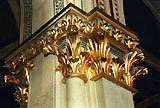
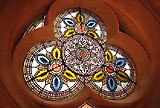
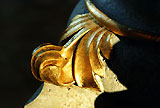
The Arkadenhof
With a surface of 2,804 square metres, the Arkadenhof is one of the biggest inner courtyards in Europe and comparable to the courtyard of the Doge's Palace in Venice. A choir-type oriel along its western wall is a reminder of the original project to build a chapel in the City Hall. Below this oriel, Friedrich Schmidt's craftsman's emblem is a memento to the architect of the building. Lined by five-metre-wide, pointed-arch arcades, the courtyard offers a fascinating setting for a wide variety of events. A folding roof designed by the architect Silja Tillner is a new addition to protect visitors against wind and rain.The Senate Chamber
In line with Friedrich Schmidt's original design, the Senate Chamber serves as the meeting-room of the City Senate. A special attraction of this hall is the beautiful majolica fireplace - a present by the Guild of Stove and Fireplace Makers dating from 1885 - on the wall facing the entrance to the hall. This is one of the most impressive rooms of the City Hall. The walls are covered with green silk damask. The ceiling - which features inlay work and gilt elements - is intricately and richly adorned. Another remarkable characteristic is the gallery of Mayors' portraits, which after the First World War replaced likenesses of the Austrian Emperors. The collection of Mayors' portraits begins in 1853 with Johann Kasper von Seiller. The likeness of the last Mayor to die is given a place of honour on the front wall of the hall. In the course of time, the portraits are thus transferred, one by one and in the clockwise direction, to the Red Salon, from where the oldest are relocated to the Historical Museum of the City of Vienna.
The entrance to the Senate Chamber is decorated with busts of Johann Strauss and Ferdinand Georg Waldmüller. Four marble plaques on the walls list the names of all Honorary Citizens of the City of Vienna (from 1797 to the present).
The Stone Halls
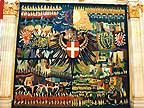
The Stone Hall I (Steinsaal I) is mainly used for marriage ceremonies and press conferences. A tapestry depicting the reconstruction of the city after 1945, the coat-of-arms of Vienna and a painting (View of Vienna, 1890) create an atmospheric setting for these events.
The Stone Hall II (Steinsaal II) is adjacent to the Great Coat of Arms Hall and often provides an impressive setting for marriages.
The Nordbuffet
Smaller rooms - the Nordbuffet and Südbuffet - adjoin the Festival Hall to the north and south. Originally conceived as salons for celebrations of the nobility, they were later transformed to house chamber music performances and buffets. Today the Nordbuffet is used as a conference venue. Silk damask tapestries, splendid cut-glass chandeliers and the ornately carved, gilt ceiling made of such expensive woods as Brazilian rosewood and mahogany endow this room with a special atmosphere. The Südbuffet contains the office of the Mayor.
The Coat of Arms Halls
The Coat of Arms Halls (Wappensäle) were given their modern outlook as late as in the 1960s. Until then, the premises housed the collections of the municipal arsenal, which were later relocated to the new building of the Historical Museum of the City of Vienna in Karlsplatz square. The "Little Wappensaal" features wall-hangings representing the coats-of-arms of all nine federal provinces and the Republic of Austria. Its larger companion offers us a glimpse of the stylised coats-of-arms of the provincial capitals. Moreover, both halls impress with ornate coffered ceilings (inlay work), massive lead-crystal chandeliers and silk damask tapestries under monument protection.
The Grand Staircases
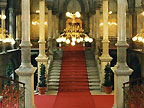 The Grand Staircases I and II are amongst the architectural highlights of the City Hall. As everywhere in the building, stones from different regions of the Austro-Hungarian monarchy were used. The broad, steep flights of stairs with wrought-iron railings are bathed in brilliant light effects created by the multicoloured tracery windows. From between columns and pointed-arch vaults, visitors may enjoy a variety of aspects of these magnificent stairways. At mezzanine level, we find the longest cloakroom of Austria, designed in the historicist style. The coat-of-arms of Vienna, conferred on the city by Emperor Frederick III, is chiselled above the entrance to the Festival Hall (via Grand Staircase I).
The Grand Staircases I and II are amongst the architectural highlights of the City Hall. As everywhere in the building, stones from different regions of the Austro-Hungarian monarchy were used. The broad, steep flights of stairs with wrought-iron railings are bathed in brilliant light effects created by the multicoloured tracery windows. From between columns and pointed-arch vaults, visitors may enjoy a variety of aspects of these magnificent stairways. At mezzanine level, we find the longest cloakroom of Austria, designed in the historicist style. The coat-of-arms of Vienna, conferred on the city by Emperor Frederick III, is chiselled above the entrance to the Festival Hall (via Grand Staircase I).
The cloakroom at mezzanine level of the Grand Staircase I is 50 metres long and can accommodate up to 1,700 hangers.
I guess that that was a lot more information than I originally thought it was. But that's good, because now when things are mentioned in my photo captions, you'll know what I'm talking about. I hope.
And I'm going to add more about the Ball Season in here because I don't think I did it justice the last time I wrote about it. It's also going to be short because I have an interview tomorrow and it's almost midnight here.
We'll start off with a bit more about the Hofburg, where the Technische Universität hosted their ball.
Hofburg Imperial Palace is a palace in Vienna, Austria, which has housed some of the most powerful people in Austrian history, including the Habsburg dynasty, rulers of the Austro-Hungarian empire, and currently serves as the official residence of the President of Austria. It was also known as the winter-residence, while Schönbrunn Palace was the preferred summer-residence.
The Hofburg area has been the documented seat of government since 1279 for various empires and republics. [1]
The Hofburg has been expanded over the centuries to include:
-
- various residences (with the Amalienburg);
- chapels (Hofkapelle, Hofmusikkapelle, Burgkapelle);
- museums (the Naturhistorisches Museum & Kunsthistorisches Museum);
- the Imperial Library (Hofbibliothek now the Prunksaal);
- the treasury (Schatzkammer);
- the national theatre (Burgtheater);
- the riding school (Hofreitschule); and,
- the horse stables (the Stallburg and Hofstallungen).
The Hofburg faces the Heldenplatz ordered under the reign of Emperor Francis Joseph, as part of what was to become a Kaiserforum that was never completed.
Numerous architects have executed work at the Hofburg as it expanded, notably the Italian architect-engineer Filiberto Luchese (the Leopoldischiner Trakt), Lodovico Burnacini and Martino and Domenico Carlone, the Baroque architects Lukas von Hildebrandt and Joseph Emanuel Fischer von Erlach (the Reichschancelry Wing and the Winter Riding School), Johann Fischer von Erlach (the library), and the architects of the grandiose Neue Burg built between 1881 and 1913.
The Hofburg in Vienna is the former imperial residence. From 1438 to 1583 and from 1612 to 1806, it was the seat of the kings and emperors of the Holy Roman Empire of the German Nation, thereafter the seat of the Emperor of Austria until 1918. Today it is the official seat of the Austrian Federal President.
The oldest sections originate from the 13th century and were primarily constructed by the last of the Babenbergers or by Ottakar II of Bohemia. Previously the castle of the Austrian rulers had been located on the square called "Am Hof," which is near the Scottish Monastery (Schottenstift).
These oldest sections of the castle form a square, surrounding what corresponds somewhat to today’s Swiss Court (Schweizerhof). There situated are a gothic chapel (Burgkapelle), from the fifteenth century, and the treasury (Schatzkammer)[2], which holds, among other objects, the Imperial Insignia of the Holy Roman Empire (Reichskleinodien) and that of the Empire of Austria. The Imperial Music Chapel (Hofmusikkapelle) is also located in this area. This Swiss Court was built during the reign of Emperor Ferdinand I in the style of the Renaissance. Its famous red-black Swiss Gate (Schweizertor) displays the many titles of Emperor Ferdinand I and the insignia of the Order of the Golden Fleece. The lower section of this wing once accommodated the imperial kitchen.
Although not physically connected to the rest of the complex, the Imperial Stables (Stallburg) of the Hofburg were originally built as a residence for the then crown prince Maximilian II. It is said that Ferdinand I did not wish to house his son under his roof, being that Maximilian had veered towards Protestantism. This structure later accommodated the art collection of Archduke Leopold Wilhelm, the art-inclined brother of Emperor Ferdinand III. This collection forms the core of the later Kunsthistorisches Museum from 1889. Only later were the Imperial Stables used to house the imperial horses, and even today it is still used by the Spanish Riding School (Spanische Hofreitschule).
Across from the Swiss Gate is the Amalienburg, named after Amalie Wilhelmine, the widow of Joseph I. However, this wing had already been in use for more than a century, constructed as the Viennese residence of Emperor Rudolph II in the style of the late Renaissance. Of note is the small tower with its dome and the astronomical clock on its façade.
The connection between the Amalienburg and the Swiss Court is the Leopold Wing which was first erected in the 1660s under Emperor Leopold I. The architect was Filiberto Lucchese, but after the Siege of 1683 by the Turks, the wing was rebuilt by Giovanni Pietro Tencala with an additional floor installed. Through its architecture, this wing still bears a connection to the Late Renaissance. It is in this wing that the offices of the Federal President are located. The lower section of this wing as well as that of the Amalienburg served as the enormous wine cellar for the Hofburg.
Originally a free-standing structure, the Imperial Library (Hofbibliothek) was housed on the other side of the complex. Charles VI founded the library, which is now called the Prunksaal, cared for by the Austrian National Library (Österreichische Nationalbibliothek). Its construction was begun by Johann Bernhard Fischer von Erlach and finished by his son Joseph Emanuel in 1735. This magnificent hall contains the book collection of Prince Eugene, an enormous ceiling fresco by Daniel Gran, and statues of emperors by Paul Strudel making this part of the Hofburg its most significant in artistic terms. The exterior decoration with Attika figures was executed by Lorenzo Mattielli in 1726. He placed a statue of Pallas Athene riding on a quadriga above the main entrance. On the left portion of the roof, he situated Atlas, supporting the celestial globe, flanked by Astronomy and Astrology, and on the opposite side, Gaia with the terrestrial globe, flanked by allegories of Geometry and Geography.
An additional father-son collaborative project resulted in the Winter Riding School (Winterreitschule) across from the Stallburg (and where the first Austrian parliament sat in 1848) and in the Imperial Chancellory Wing (Reichskanzleitrakt) across from the Leopold Wing. The latter was originally planned by Johann Lucas von Hildebrandt and accommodated, in addition to the Aulic Council (Reichshofrat), the offices of the Imperial Vice Chancellor (Reichsvizekanzler), who was the de facto prime minister of the Holy Roman Empire since the position of Imperial Arch-Chancellor (Reichserzkanzler)—which the Imperial Vice Chancellor represented—had always been filled by the Archbishop of Mainz since the Middle Ages. After the end of the Holy Roman Empire, this wing housed the apartments of the Duke of ReichstadtFrancis Joseph I. (Napoleon II) and later those of Emperor
The Michael Wing was also planned by Joseph Emanuel Fischer von Erlach, and it serves as the connection between the Winter Riding School and the Imperial Chancellory Wing. However, because the old Imperial Theatre (Burgtheater) stood in the way, these plans remained unrealized until Ferdinand Kirschner built the wing from 1889 to 1893, utilizing a slightly altered plan.
More structures and annexes were successively added. Particularly from 1763 to 1769, Nicolaus von Picassi connected the Imperial Library to the other parts of the Hofburg and its other side to St. Augustine’s Church (Augustinerkirche), and he thus created the present Joseph Square (Josephsplatz), one of the most beautiful locations in Vienna. After the renovation of the Albertina in the 1820s by Joseph Kornhäusel, that section became connected to the Hofburg as well.
In 1809, a part of the old bastion adjacent to the old castle was demolished in the course of the Napoleonic Wars. All the way up to the present Ringstraße, new grounds were laid, in which the neoclassical Castle Gate (Burgtor) was integrated. Within the new walls which were erected in 1817, three gardens were laid: the private Imperial Castle Garden (Burggarten), Heroes Square as a lawn with boulevards, and the People’s Garden (Volksgarten) with the Temple of Theseus (Theseustempel), which, along with the Burgtor, was designed by Peter von Nobile. A further addition from this period (already by 1804) is the Hall of Ceremonies (Zeremoniensaal) by Louis Montoyer, which at that time was a protrusion jutting out of the complex. It was quickly regarded as unpleasant and named the Nose (Nase). However, today it is fully integrated into the New Castle (Neue Burg).
Following the enlargement of Vienna after the demolition of the city walls in the 1860s, the Hofburg had its last great expansion. An Imperial Forum (Kaiserforum) was planned—a two-winged structure reaching beyond the Ringstraße, with the twin museums (Kunsthistorisches Museum and Naturhistorisches Museum) as flanks and terminating at the old Imperial Stables (the Hofstallungen, not to be confused with the much older Stallburg) of Fischer von Erlach. The project was led by Gottfried Semper and later by Karl Freiherr von Hasenauer. The museums were completed in 1891, but construction of the rest of the forum dragged on slowly and conflicted since, besides ostentation, no real function could be found for the enormous construction project. In 1913, the south-west wing, the New Castle (Neue Burg), was completed. However, the Imperial Forum was never finished. In its place, Heroes Square (Heldenplatz) and Maria Therese Square (Maria-Theresien-Platz) were laid. The New Castle wing today houses a number of museums (the Ephesus Museum, the Collection of Arms and Armor, the Collection of Ancient Musical Instruments, and the Museum of Ethnology) as well as the reading rooms of the Austrian National Library and the Hofburg Congress Center of international renown. Equestrian statues of the two most important Austrian field marshals, Prince Eugene of Savoy and Archduke Charles, stand at the foci of Heroes Square. On March 15, 1938, Adolf Hitler proclaimed from the balcony of the New Castle onto Heroes’ Square the “Anschluss” of Austria into the Third Reich (Deutsches Reich).
Of note are the equestrian statue of Emperor Joseph II by Franz Anton Zauner at the center of Joseph Square as well as the statue of Francis I in the Inner Castle Court (innerer Burghof) by Pompeo Marchesi. After the completion of Michael Square, two sculpted fountains were installed on its façade: Power at Sea by Rudolf Weyr and Power on Land by Edmund Hellmer.
On the night of November 26/27, 1992, a large fire originated in the Hofburg in the area of the Redoutensäle on Joseph Square. A part of the roof as well as that of the upper floor burned completely down. Its renovation was completed by 1997, and the newly-rebuilt sections now contain wall and ceiling paintings by Josef Mikl.
And now more about balls in general...Th
The Beginning
Historically, during Fasching the lower classes were allowed to wear costumes and masks and to mimic aristocracy and heads of church and state without fear of retribution for mockery. When things got out of hand, the custom was forbidden, for a while anyway. Even Empress Maria Theresia (1717-1780) decreed at one point that masks would no longer be allowed in the streets; whereupon the revelry was moved indoors.
This was the beginning of the splendid balls, for which Vienna has become so famous and the real business of Fasching is, first and last, dancing, but it is also a season of jollification for the entire city.
The Season
The ball season starts with the New Year's Eve Imperial Ball (Kaiserball) at the Hofburg and ends with the Opera Ball in February. The season officially lasts until Ash Wednesday (Aschermittwoch). But in reality, you may attend a ball as early as November and as late as June.
Something for Everyone
There are some three hundred balls during this period. Of these about thirty are leading social events. The most famous are the Opera Ball, the Imperial Ball and the Philharmoniker Ball, which is organized by the famous Vienna Philharmonics. Others are the Physicians' Ball, the Hunter's Ball, the Flower Ball, the Coffeehouse Owners Ball and the Rudolfina Redoute. Full evening dress is obligatory at these principal events or hunting dress in the case of the Hunters' Ball, though there are some elaborate fancy dress occasions, and a children's costume ball. At the redoutes women are disguised in small romantic eye masks.
There remain the other two hundred and seventy-odd events of the Fasching calendar. These are balls too, for the Viennese must dance always, but they are less expensive, less formal. There are postman's balls, police balls, factory balls, balls organized by every social club in every district of the city; Residents become weary of being asked for subscriptions to subsidize these functions, but no true Viennese would wish it otherwise.The Ball Season in Vienna: Positive Romanticism
Vienna is the only place in the world where balls, as distinct from the smaller modern dinner dance, still rule the social life of winter. Balls in the Hofburg Palace (Imperial Palace), where the Habsburgs reigned, in concert halls and the Opera House, under glittering chandeliers, among mirrors which multiply the hundreds of dancers to thousands. Balls where evening dress is de rigueur, where each debutante wears a little crown like a prima ballerina, women carry fans, and music and champagne blend with the jewels and color, laughter and wealth.
To the foreigner there is something unreal in any of these balls. We are not accustomed to such positive romanticism. A hundred years ago every court in Europe held receptions such as these; London, Paris, all the capital cities had their seasons in the days when the guests arrived in their own carriages with coats of arms painted on the doors. Now we only know this particular form of gaiety from films and plays and as the background of operetta. Could it ever have existed outside the frontiers of Ruritania? It did, and does in Vienna today.
Alles Waltzer
The past at its best: Lush luxury, true elegance and distinguished manners performed with grace and enjoyed a whole fairy tale night long - that means visiting a ball in Vienna.
Throughout the night, one is surrounded by beauty: Vienna's balls usually take place either in a lovely old mansion, formerly owned by a member of the aristocracy; in a prince's former town palace; or, at the most desirable location in all of Vienna, the great halls of the Imperial Palace (Hofburg). And Vienna's ballrooms are dressed to the hilt, as it were, - quite suitable for the occasion: decked out with thousands of flowers, the walls adorned with magnificent trimmings and ablaze with glittering lights, they evoke an atmosphere of elegance and tradition.
At the more elegant balls, liveried footmen may greet the ball goers, who come attired in gowns that will be discussed in next morning's paper, the ladies bejewelled, the gentlemen in black or white tie, complete with decorations. Fanfares announce the beginning of the ball. To the tune of a formal polonaise, the debutantes of the season and their escorts - the young girls almost always dressed all in white, the young men in white tie and tails - open the ball; until some time ago, the opening of an important ball was the equivalent of a "coming-out" for upper-class debutantes in Vienna.
Nowadays, young people from all walks of society simply enjoy themselves. Some introductory words are spoken by an official and the first dance is invariably a waltz, still danced to perfection by these young scions of society. Only after the opening waltz is concluded does the dance master call out the words everyone has been waiting for: Alles Walzer! ( - Everybody Waltz). It is then that dance floor is turned over to the rest of the guests and becomes the arena of all ball goers. And everybody does indeed waltz - dancing goes on through the night in the main ballroom, even though the secondary rooms may resound with modern dances, maybe a jitterbug, a tango, disco tunes or house beats.
Champagne Flows
Champagne is the drink of the night. And at some balls, being seen by or with the right people counts as much as the good time one is having.
Most balls last until two or three o'clock in the morning, some of them until five. After midnight, a hearty Gulaschsuppe (gulyas soup) may be served to provide strength to the untiring dancers. Usually, it is the "kids" that remain until the wee hours of the morning - their energy seems to be boundless. Going home after a ball? No way! There's still time for a Katerfrühstück, a "hangover breakfast." And if no coffeehouse is open that early (even though some coffeehouses extend their opening hours during the ball season), there's always a hot dog stand somewhere near the ballroom. It is not unusual, during Vienna's ball season, for early risers on their way to work to encounter a group of lively youngsters in splendid gowns and formal suits, in elegant coats with silk shawls wrapped around their necks devouring a hot dog at an all-night Würstelstand.
Vienna's ball tradition also demands a Damenspende, a present for the ladies to take home. Originally, the present was designed to hold the Dance Card where all dances of the night were listed and young men reserved their dance with a particular young lady by writing their name next to the dance they desired. Around the turn of the century, these Damenspenden were unusually inventive - some, signifying the advent of the modern age, consisted of miniature steam locomotives or tiny sewing machines. Today, the Damenspenden may be somewhat more prosaic - an exquisite perfume, a nice waltz CD or a lovely piece of custom jewelry - but still meant as a compliment to the lady.
Vienna's debutantes have prepared for many months for their grand entrance by first attending one of Vienna's elegant dance schools and later rehearsing the opening ceremony and waltz on location. Dance schools such as the famous Elmayer's or Fränzl's, offer "crash courses" for ballgoers visiting from outside Vienna, or outside the country, at reasonable prices.
And of course, visitors to the city don't always travel with a ball gown or tuxedo in their luggage - here, too, numerous rental places specializing in ball gowns and formal wear come to rescue. The Viennese themselves also often make use of them and may rent a ball-gown or two if they are to be seen at different balls during one season.
All that goes to show that the Viennese love celebrating carnival, the days preceding Lent season, called Fasching in Vienna, which usually last from the beginning of the New Year until Ash Wednesday. Despite the love of the Viennese for festive occasions, it is all the more surprising that Vienna, unlike Venice, Rio de Janeiro or Cologne, does not have an extended period of cavorting in the streets and hardly any parades of masked revelers - one exception being the parade of the "Faschingsgesellschaft" which takes place in a different district of Vienna every year - even though one finds some famous Carnival parades in the Austrian countryside.
This tradition, or lack thereof, goes back to one of Austria's much respected rulers, Empress Maria Theresia (1717 - 1780). Despite being admired by her people, she often played the role of a stern mother figure: she did not approve of the Viennese Fasching of her day, which still included wearing masks on the streets, because brawls and tumult sometimes erupted under the cover of anonymity. Therefore she banned the wearing of masks in the Viennese streets. But she permitted the aristocrats at her imperial court to celebrate with masks inside their own "homes" (which were, in fact, palaces or at least mansions).
After her death her son Josef II, a "People's Emperor" who was even closer to the Austrian people - especially the working class - than his mother, relaxed her rule to include permission for all Viennese to celebrate Fasching indoors, with or without masks.
At that time, balls were rather sedate affairs, with stylized minuets, gavottes, polonaises and other dances involving very little body contact. What no one could foresee was the infusion of a new musical energy that the advent of the waltz brought to Vienna and, thence, to the rest of the world. At first, the waltz was considered exceedingly immoral: the constant invitation of today's dance masters, much to the chagrin of timid young girls and boys, namely Tuchfühlung ("Get closer!") was precisely what outraged the old guard at that time. In 1787, Johann Count Fekete described a ball where waltzing was done: "It was wild and immoral. The women behaved in a Bacchanalian manner, all innocence fled from the place." And the Duke of Devonshire declared unequivocally: "I would never marry a woman who dances the waltz!"
The Waltz Takes Off
However, there was no stopping the popularity of the waltz. And with the appearance of the Strauss dynasty on the international waltz scene, waltzes began to reign supreme in the ballrooms of the world. In 1837, the waltz obtained legitimacy with a royal stamp of approval, when Johann Strauss Father composed and played a waltz at the coronation of Queen Victoria. He later dedicated his Myrtle Waltz to her on the occasion of the wedding of "Her Majesty Queen Victoria to his Royal Highness Prince Albert of Saxe-Coburg."
Throughout the nineteenth century, balls became the order of the day during Fasching for all levels of society - not even the revolution of 1848 put a stop to it; on the contrary: the rising star Johann Strauss Son composed a Revolution March, took it to the barricades - and had to suffer some consequences for it. Later, it was played in Vienna's ballrooms.
Even though every Viennese was now entitled to attend a ball, the Viennese Fasching still mirrored the class system of Viennese society: while the gentry celebrated at their mansions or at the Imperial Palace and the bourgeoisie rented elegant establishments, the rest of the people gathered in inns and taverns near their homes, often on the outskirts of the city.
Toward the end of the nineteenth century, various professions and guilds began to create their own balls: in Vienna, to this day, there is hardly a professional group without its own ball. Waiters, chimney sweeps, pastry makers, hatmakers, detectives, flower girls or chamber maids each celebrated and still celebrate Vienna's Fasching season. One of the liveliest and merriest of all Viennese balls, without a doubt, used to be the Wäschermädel Ball (The Laundry Maids' Ball). Technologists created the Techniker Cercle, physicians the Ärzteball, lawyers the Juristenball. And of course, with coffeehouses experiencing their heyday in Vienna, there was a separate Kaffeesiederball (Ball of the Coffeehouse Owners). Many of these balls are still put on today - and will probably last well into the third millennium.
Have A Ball
There are balls for every taste and (every pocketbook) in Vienna. At New Year's Eve, the elegant Kaiserball (Imperial Ball) at the Imperial Palace (Hofburg), a relatively recent ball, attracts tourists and Viennese alike.
Of course, the crowning glory of Vienna's ball season or, for that matter, the European ball season, has traditionally been the Vienna Opera Ball, held at Vienna's venerable State Opera whose stage and auditorium are transformed into a giant dance floor. This is an event of such magnitude in Austria that it is broadcast live on television - and everybody participates, be it in dazzling ballgowns at the ball itself or watching it in the comfortable surroundings of one's home.
The Jägerball (Hunters' Ball) is a special event, where almost everybody turns up in elegant versions of Austria's native dress. The floor-length dirndls of the ladies are made of velvet and silk and the Alpine jackets of the men of the finest materials.
One of the highlights in this city where music reigns supreme is, of course, the ball put on by the Wiener Philharmoniker at their "home," the Musikverein concert hall: the members of the Vienna Philharmonic Orchestra put aside their instruments and let another orchestra play for them - to dance themselves for a change!
The Rudolfina Redoute is the only masked ball of significant stature in Vienna - and until midnight, the floor belongs to masked ladies: it is ladies choice until then. If your heart is set on an elegant masked ball, of which there are not that many in Vienna, this Redoute at Vienna's Imperial Palace may be your best bet. But if you wish to wear a mask in less intimidating surroundings, you can participate in one of the numerous Gschnasfeste, usually organized by young artists and bohemians, where the motto is: anything goes!
Of course, there are numerous other balls of differing degrees of elegance. They all have some things in common: they are festive, they are fun - and they offer an occasion to dance the night away in three-quarter time.
Alternative Balls
The New York Times devoted an entire article full of praise to the alternative ball scene in Vienna: "Homeless - but my Dance Card is full". As a counterpoint to the glittering, century-old Opera Ball featuring the elite of Europe, some enterprising young people staged a Homeless Ball - the participants showed up in parkas, sneakers and baseball caps. Organized by the homeless magazine Augustin, this ball is a counter-culture response to the famous opera ball (Opernball) - however, it is a fair guess that not many opera ballgoers will visit the Opferball (Victim's Ball) by mistake &ldots;
Different other ideas for privately organised balls appear every year. You have to look for them in the Ballkalender. One was or perhaps still is the Ball des Schlechten Geschmacks, which strived hard to remain true to its name - literally: Ball of Bad Taste - very trashy, bad music, awful clothes. Another one was the Mauerblümchenball: Despite its name no one was left out at the Wallflower Ball - the rule was that colorfully dressed people where not even permitted to enter: only if one wore such drab colors as beige and gray one was certain of admittance. And at midnight, the drabbest wallflower obtained a prize!
The Life Ball, which usually takes place in May, is not only one of the biggest charity events in Europe (all proceeds go to help of victims of AIDS or HIV), but has also become one of the most glamorous events of Europe's social life. Thousands of visitors dance the night away and enjoy fashion shows of international designers as well as live acts, hot music and sexy go gos. There is no doubt that this is the most avant-garde ball in Vienna - it is hip and it is zany!
All Good Things Must End
The official Ball season and Fasching come to an end with Ash Wednesday the beginning of the 40 days of Lent, However there are balls for months to come and you have a chance to waltz into the month of June.
Many thanks to Wikipedia and Virtual Vienna for all their wonderful information. And since it is now slightly after midnight, I'm going to get my shower and get to bed. I have a big day tomorrow!Love always,
Amanda
PS -- I hope this keeps ya'll busy for the next few days. I'll try to get another post in on Friday night before I leave for Berlin for ten days. My laptop will be staying behind, but I'll have my camera and a notebook so I don't forget anything. :-) Photos will be captioned and hopefully more added in the next few days. If I need to find a new host, I'll post that link too.
Sunday, January 28, 2007
Catch Up for Real This Time...
Thursday, January 25, 2007
I'm a dork, so I started my Ball prep in the morning, since I had some extra time and the other girls were at class, so I had our bathroom all to myself. Most of the conversations before and during German class centered around who got dresses, who still needed to go shopping, what colors dresses were, how long they really had to be, etc. I got to be smug because I brought my green dress with me. I absolutely love that dress. It's a green velour halter A-line, with a slit up the left leg so I can walk. I got it for junior Harvest, and have probably worn it five or six times since. I think I like it better than even my prom dress.
I was the only person in the apartment when I first got there, so I decided to make dinner for myself since the Ball didn't start until 9:30. I more or less wasted time until about 7:30 because I didn't have a lot to do, but the flatties wanted to leave by about 8:30 to get to the Hofburg. The Ball was hosted by the Technical University of Vienna, and the Hofburg is the Imperial Palace. It is across the Ring from the Kunsthistorisches Museum and the Naturhistorisches Museum. I curled my hair and put it into a low pony tail because I'm fancy-hair challenged. I decided to wear my pearl earrings and the gold omega necklace. Since I don't have any bracelets here with me, I went without anything on my wrists. Then I had my little black purse, the black shawl, and the strappy black heels. I got a "very nice" from the boys when I walked out of Natalia's and my room. We had a champagne toast and took the obligatory "pre dance" pictures, and then it was time to walk down to the S-Bahn and get to the Ball. Yes, I know, public transportation to an extremely elegant event, but we knew we'd have to pay for a taxi coming home and didn't feel like spending the extra Euro beforehand.
After we had changed S-Bahns, I got that nervous-excited feeling, like the butterflies you get when you're really looking forward to something. We walked in and checked our coats, but I decided to keep my purse at the table with me so I could take pictures. By the time we got up to the main dance hall, there were too many people in the doors to see the debutantes' first dance in society. In Vienna, the women between the ages of 18 and 25 can be debutantes. I'm not really sure how they become debutantes or anything, but each one wears a white dress and dances the opening dance with her date. They have the dance choreographed, and there were ballerinas in the middle of the floor dancing with them too. One of the other IES girls got a video of it, which I'll "borrow" from her at some point in the future.
Some of the other girls and I stood near one of the entrances to the main dance hall so we could check out possible dance partners. I got asked by an Austria only a few dances in. I danced three dances with him, and I couldn't understand his accent very well, so conversation was lacking. We danced the samba, the waltz, and maybe a cha-cha. He was a good lead, so it was fun, and I'm really glad I took the ballroom class at Penn State with Jolene, or else I would have been lost during those dances. I just want everybody to know that I samba-ed extraordinarily well for not doing it for over a year. :-) After those three dances, I dance two with IES guys, and at points, as one of them put it, it was like playing football and knocking into people because the floor was so full. I decided to take a bit of a break after that, and it was getting close to midnight anyway, when they would dance the first quadrille. I was up on the main stairs and a boy named Ingomar asked me to dance. I said sure. The quadrille is kind of like the Austrian equivalent to squaredancing. Everyone lines up in two lines. Each quadrille is made up of two men and two women. There is a caller, who directs the dance in German, so Ingo translated for us. At the end of the sixth round of calls, everyone kind of polkas under each others arms which are held up like little kids playing "London Bridge." And people will drop their arms randomly too and trap people. It was fun, but it didn't smell so great. After the quadrille, they played another waltz, but the floor was extremely crowded and Ingo and I only got partway around. We decided to take a bit of a break and he took me to meet some of his friends at a table in another room. In true Germanic fashion, we discussed politics. I did decently well, since the conversation was in English, but since Ingo is majoring in Physics and Mathematics, he likes to take charge of the conversation in any language. Being the polite person that I am, I let him. Around 1:30, it was time to check on the flatties and see what was going on.
Travis got The Look, so he and Natalia and Matt and I went down to the salsa room in the lower level of the Hofburg. We did more swing-like things than salsa (sorry, Matt, but I don't remember much, you'll have to re-teach me when I get home), but we had a lot of fun. My feet were hurting and Travis needed a break, so we went back up and sat at the table with the other flatties. At 2:30, they danced another quadrille. I didn't take part in this one, but I did take a lot of pictures and some videos too. Matt and I took a turn in the jazz room and I learned to foxtrot. Just the basic, but it was fun. Then it was back to the table for us. It was getting really late at this point and we needed to get home, since most of us had presentations or exams in class the next day. By the time we had all the flatties rounded up, it was headed toward 3:45. Jeremy, Alison, and I were in one taxi and the others followed us. We got back and changed into our pj's and compared pictures. I called Matt to tell him about the Ball. And then we passed out around 4:15.
On Friday, I got to sleep until about 9:00 and I was pretty impressed because I didn't look like I had been up until 4am the night before. One of the girls even commented on it when I was at IES. It was sehr toll. I had to be at IES a little bit early because Mary, Mandy, and Violetta and I were doing a group presentation in class and we had to put it together. I left the apartment around 10:30, but I straightened up before I left, like doing dishes and fixing pillows and such, because our cleaning lady comes on Friday afternoons. Our landlady also accompanies her. I just think it's ironic that we clean for the cleaning lady.
Our presentation went well, and the quiz/test wasn't as terrible as the first one we had the week before. After class, I had to wait at IES for a bit because I had my interview for the business internship. There were about ten of us that would be in the class and then have the internships. We each got three top picks for the internship we would like. My favorite was an internship with a branch of the Economist, a magazine published in Europe. I would be doing research and writing, and might even get published. My second choice was with a group doing research on management trends, and my third was with a bank doing stock analysis. I know that that doesn't make any logical sense because I'm studying Finance, but I think I want to get my PhD in Economics and teach at the collegiate level.
I had planned on coming home to change and then head back to the first district to see Anne in an opera, but when I got home and had something to eat and done my laundry, I just didn't feel like going out again. It had been getting cold the last few days, and the girls had a class field trip to a Heuriger (mine is tomorrow) and the boys were watching the Family Guy movie. So I stayed in and worked on travel plans for St. Patrick's Day weekend and Easter break. I went to bed early that night (like around 11 or so) and called Matt and Erika.
Saturday, January 27, 2007
Yesterday was kind of like market day. I did all my food shopping, and I think I managed to hit up most of the major Austrian chains in the process. I've started shopping according to sales, and I manage to get pretty much everything I need for several days for only about 25 Euro. Everything also includes ginormous Milka bars with almonds. :-) Spar, one of the markets on the corner, didn't have any chicken on sale, but I'm going to check again tomorrow before class. I like to cook it up and make sandwiches and different dinners with it during the week. And all I need right now is the chicken, because I have everything else to make chicken parmesan.
We also got some snow yesterday afternoon. Maybe an inch or so. This prompted me to take lots of outdoor pictures, and also some of our apartment and the flatties. So now you can see what they look like when I put them up tomorrow afternoon. We talked about going ice skating after dinner, which was goulaschsuppe. Sarah made it and the rest of us girls played sous chef. It turned out a bit more like beef vegetable soup, but it was amazing. I had two big bowls. We broke open a few bottles of wine and sat around and talked til about 9:30. Since the rink we were going to is only open until 11:00 and it costs about 11 Euro to rent skates and for admission, it wasn't really worth going out. Then Jeremy woke up from his nap and told us that Tobi, one of the student assistants at IES, was going to rapping at a local club. Around 11:30 we pulled ourselves out of our warm, comfortable apartment and walked through the snow to the club. I got talked into going at least for a while. We got lost a couple of times and had a snowball fight.
The club was more like a hooka lounge with a basement. Tobi was in the basement and there was a LOT of IES kids there. Like maybe 25 or so. It was about 1:00 before he came on. Then there was some dancing, but it was a bit smokey in there -- both kinds, pot and cigarette. It was a somewhat new experience. But it was a pretty good time. We left around 1:45 as a "family." I love my flatties. We're awesome. I stayed up and talked to Matt online until obscene hours of the night. And then I proceeded to sleep until noon and I'm still sitting around in my pj's. I might not even change out of them so I don't have to do more laundry.
And that's all there is to tell. I think I'll probably end up bumming around for the rest of the day, but we talked about maybe going to see a Mass at St. Stephen's in the first district tonight. We'll see. Pictures posted tomorrow from the Ball and this weekend. And I'll go through Facebook tomorrow and borrow pictures from people there too.
Love and Kisses,
Amanda
